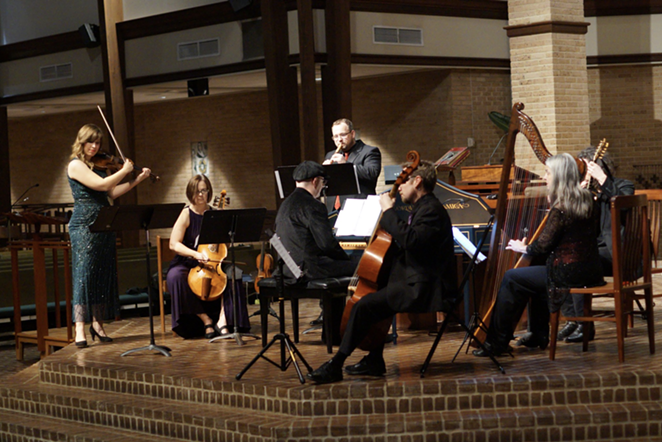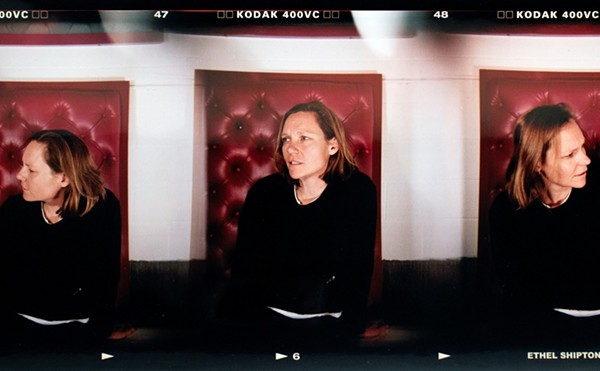The Austin Baroque Orchestra is Here to School Us on Romantic Music This Weekend
By Brian Holmes on Fri, May 31, 2019 at 11:44 am
This Sunday, the “Austin born-and-bred ensemble,” the Austin Baroque Orchestra, will visit San Antonio and perform a selection of Classical and Romantic pieces that are rarely featured under the title “Eine Kleine Kammermusik” (literally, ‘a little chamber music’). The small sampling of music is aptly selected from men who were in correspondence with one another as they composed, resonating Romantic passion in their attempt to escape from the rigidity of Mozart’s and Haydn’s Classical era. Yet, these timbral overreachers, Ludwig van Beethoven, Antoine Reicha and Louis Spohr, did not completely deviate from their predecessors. Instead, they injected music that had become stale with fervor and shock, turning a chuckle into a gasp.
The show will begin with Beethoven’s Piano Quartet in C Major. Ironically, the quartet is often described as “Beethoven before he sounded like Beethoven,” even though he wrote and published the piece prior to going deaf. Although music historians trace Beethoven’s shifting aesthetic tastes to the onset of his deteriorating hearing in the late 18th century, there was a clear change in not only Beethoven’s musical composition but also the sound of music itself at that time. The instrument at the heart of the ensemble, the pianoforte, underwent a transformation that included a heavier iron frame, thicker strings and the expansion to a sixth octave, which allowed for greater emotional expression with a deeper tone and more sustained notes. For this concert, the Austin Baroque Orchestra will use a replica of a 1780 piano Beethoven would have been familiar with, made from a wooden frame with lighter strings and limited to five octaves. While many musicians consider Beethoven’s later works his masterpieces, his early music was paramount in his development as a fugitive from the classicists and emergence as a pioneer of Romantic music.
Following the light quartet is a wind quintet composed by Beethoven’s childhood best friend Reicha. They met while both performing in the Hofkapelle Orchestra in Bonn, Germany – Reicha as a violinist and a flutist and Beethoven as a violist and an organist. As an astute theorist, Reicha’s works tend to be complicated, combining virtuoso showmanship, cultural elements from his personal life and academic interests such as math and philosophy. His technical fixation produced numerous fugues that promoted bitonality and polyrhythm that most of his contemporaries found disagreeable. However, the quintet that the Austin Baroque Orchestra will perform is more of a quirky response that chooses to humor the Classical era.
While visiting Paris in 1820, Spohr heard Reicha’s quintets and commented in a letter that they possessed too many ideas that were poorly connected. Aptly ending the show is Spohr’s Gran Nonetto, a seminal work which originated a standardized instrumentation that is emulated to this day. Spohr, who invented the violin chin rest, disliked the experimental styles of his contemporaries and favored a more Classical sound, but could not be helped by the forward-looking artists that surrounded him. Expect a beautiful blend of Classic formalism and Romantic sensibilities in this nine-person ensemble.
$5-$25, 4pm Sun. Jun. 2, Chapel of the Incarnate Word, 4503 Broadway, (210) 828-2224, austinbaroqueorchestra.org
Get our top picks for the best events in San Antonio every Thursday morning. Sign up for our Events Newsletter.
The show will begin with Beethoven’s Piano Quartet in C Major. Ironically, the quartet is often described as “Beethoven before he sounded like Beethoven,” even though he wrote and published the piece prior to going deaf. Although music historians trace Beethoven’s shifting aesthetic tastes to the onset of his deteriorating hearing in the late 18th century, there was a clear change in not only Beethoven’s musical composition but also the sound of music itself at that time. The instrument at the heart of the ensemble, the pianoforte, underwent a transformation that included a heavier iron frame, thicker strings and the expansion to a sixth octave, which allowed for greater emotional expression with a deeper tone and more sustained notes. For this concert, the Austin Baroque Orchestra will use a replica of a 1780 piano Beethoven would have been familiar with, made from a wooden frame with lighter strings and limited to five octaves. While many musicians consider Beethoven’s later works his masterpieces, his early music was paramount in his development as a fugitive from the classicists and emergence as a pioneer of Romantic music.
Following the light quartet is a wind quintet composed by Beethoven’s childhood best friend Reicha. They met while both performing in the Hofkapelle Orchestra in Bonn, Germany – Reicha as a violinist and a flutist and Beethoven as a violist and an organist. As an astute theorist, Reicha’s works tend to be complicated, combining virtuoso showmanship, cultural elements from his personal life and academic interests such as math and philosophy. His technical fixation produced numerous fugues that promoted bitonality and polyrhythm that most of his contemporaries found disagreeable. However, the quintet that the Austin Baroque Orchestra will perform is more of a quirky response that chooses to humor the Classical era.
While visiting Paris in 1820, Spohr heard Reicha’s quintets and commented in a letter that they possessed too many ideas that were poorly connected. Aptly ending the show is Spohr’s Gran Nonetto, a seminal work which originated a standardized instrumentation that is emulated to this day. Spohr, who invented the violin chin rest, disliked the experimental styles of his contemporaries and favored a more Classical sound, but could not be helped by the forward-looking artists that surrounded him. Expect a beautiful blend of Classic formalism and Romantic sensibilities in this nine-person ensemble.
$5-$25, 4pm Sun. Jun. 2, Chapel of the Incarnate Word, 4503 Broadway, (210) 828-2224, austinbaroqueorchestra.org
Get our top picks for the best events in San Antonio every Thursday morning. Sign up for our Events Newsletter.

KEEP SA CURRENT!
Since 1986, the SA Current has served as the free, independent voice of San Antonio, and we want to keep it that way.
Becoming an SA Current Supporter for as little as $5 a month allows us to continue offering readers access to our coverage of local news, food, nightlife, events, and culture with no paywalls.
Scroll to read more Arts Stories & Interviews articles
Newsletters
Join SA Current Newsletters
Subscribe now to get the latest news delivered right to your inbox.















